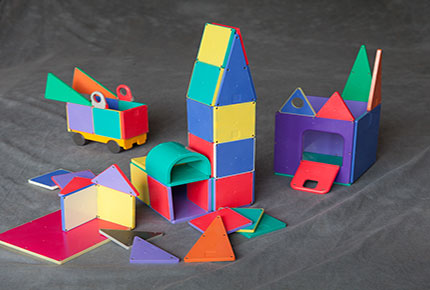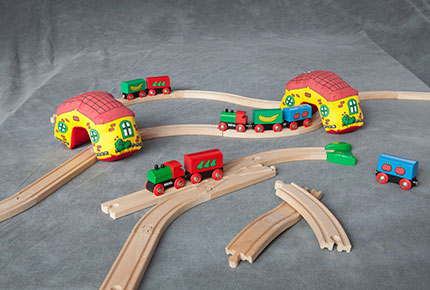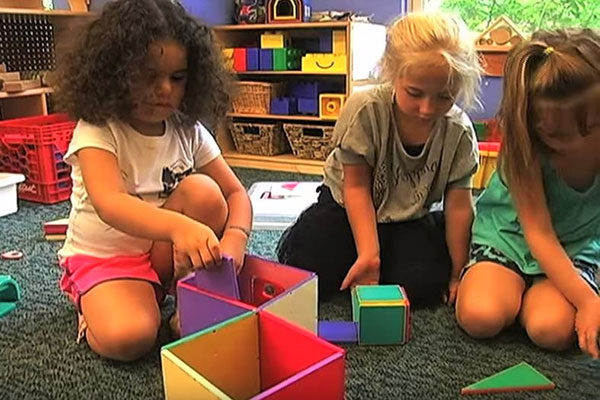2013 TIMPANI Toy Study
(This video has captions. You can turn them on by clicking the CC icon at the bottom of the video.)
Download a printable transcript.
Dr. Elsa M. Núñez, President: Hello, I’m Elsa Núñez, President of Eastern Connecticut State niversity. The TIMPANI toy study is carried out by faculty and students working together to help early childhood professionals and parents discover which toys best help children learn. I hope you find this year’s results as interesting as I do.
Dr. Jeffrey Trawick-Smith, Principal Investigator: Each year we select a number of toys that have been nominated by either teachers or parents. And we look at the impact that they have on children’s play behaviors. We look for the impact of toys on different kinds of problem solving, social interaction and language, creativity, creative expression, make believe, and even if the toy can be used autonomously. And our hope is that our findings overtime will provide a guide for teachers in selecting toys for their own classrooms.
Methods (1:15)
Jeff Trawick-Smith: How the study worked is that we would place a toy in a classroom for four days. During three of those days, we recorded what children did with that toy during free play or during center time. So this was done in very naturalistic setting. It was like real live play in a real live classroom.
Chamari Davis, Undergraduate Student Researcher: Every day we would videotape the children playing in the classrooms for 20 minutes. They would have the same toy for three days, and after the third day, we would switch out a different toy.
Cassie Savalli, Undergraduate Student Researcher: I would just watch to see if they were interacting with other students, how they were playing, if they were talking while they were playing, and what they were creating with the toys, or any kind of response.
Jeff Trawick-Smith: And then using a coding instrument that we developed in a previous study, we coded the quality of children’s play across a variety of areas. And then we used that data to kind of identify which toys tended to promote the highest quality play.
Cassie Savalli: We looked at things such as any conflict resolution, their creative thinking, if there was imagination involved. And we would score them on a scale of one to five.
2013 Study: Finding #1 (2:29)
Jeff Trawick-Smith: This year we actually had two toys thats cored very high and so close together that it was very difficult for us to decide one performed better than the other, and so we really have two toys. One is Magna-Tiles, which is a construction toy. Magna-Tiles are these pieces that have magnets on them and they stick together so that you can build different kinds of two-dimensional, three-dimensional shapes.
Chamari Davis: I think children were attracted to the Magna-Tiles because,since they were magnetic, and they have yet to understand the concept of magnets, they’re wanting to experiment with the toy—that was also something that interested them.
Cassie Savalli: Magna-Tiles was extremely popular. Every time we would watch them engage with them, there was the max amount of children in the center with those toys. They learned to build together and there was a lot of creative imagination—who was building houses,trucks, cars, planes, cameras—everything you could imagine was being built with the magna tiles.
Girl: It’s a pizza!
Cassie Savalli: Children can choose what they want to build. There’s no specific way to play with it.
Girl 1: Do you want a pizza?
Girl 2: Yeah
Patrice Ramm, Preschool Teacher: It does lend itself to a lot of cooperative imaginary role playing kind of play. Children can use them independently or they can use them together cooperatively. The younger children make simple structures with them and the older children make more complex structures. One little boy was making a house for his tiger. He needed a square and there weren’t any more squares left. So he figured out that he could put two triangles together and use the two triangles as a square and finish his house for his tiger. So there’s a lot of problem-solving.
Girl: Yay! Look at what I made!
2013 Study: Finding #2 (4:27)
Jeff Trawick-Smith: The second toy that scored very well on our study this year was a wooden toy train set. The train set itself inspired lots of make believe, lots of interaction with peers.
Boy 1: We have to deliver the apples and the pears and all the things. Okay?
Boy 2: And I have to deliver the bananas. I have a bunch of them.
Boy 1: All of them. A bunch of apples.
Cassie Savalli: There were always children playing with the trains, and that was another toy that had limited amount of pieces, but I saw a lot of cooperative, working together.
Boy 1: The train track is broken!
Boy 2: I can fix it; I can fix it; I can fix it.
Ashley Anderson, Preschool Teacher: I really liked how the trains fostered concentration. For children who usually struggle with focusing and being able to sit and concentrate on the task at hand. I found that regardless of who was in the block area with the trains, they were able to really focus. It was nice to have something where the children were able to create their own structure, but then eventually bring them all together.
Boy: Oh! Sienna, want to connect your railway to ours? Wanna do that?
Ashley Anderson: I think the trains were different from other toys because they’re a classic toy. They didn’t need sounds and lights and bells and whistles. They are simple enough in their nature that they were understood by all, regardless of gender, ethnicity. All of the children could appreciate them and had enough background knowledge to apply to the toy, but at the same time they could learn from each other and the language that they were using with the toy.
Enzo: You put your, these trains. I’ll put the other two trains, okay?
Sienna: I’ll put it in the back.
Additional Study Findings (6:23)
Jeff Trawick-Smith: One very interesting finding in our study was that the two toys were both toys that not only promoted high quality play, but they were also used very frequently by children. Children preferred playing with them. And that’s a little different than some of the other toys that we’ve discovered on other years that have scored high on play quality. We were very interested in this, because it is been found in other studies that teachers sometimes will pick toys that are very popular—that children are drawn to, that they love to use—but they aren’t necessarily the highest quality toys. And what we found here was that these two toys in particular really inspired both quality and quantity.
Implications of Study (7:12)
Jeff Trawick-Smith: I think that our study this year, as our studies in previous years, has some important implications for teachers working in preschool classrooms. Just as teachers give careful thought and observation to other elements that they include in their classroom, they should do that with toys as well.
Chamari Davis: When I’m a teacher I want to include things in my classroom that I know will meet all of the domains that we looked at, such as allowing kids to use their imagination, allowing kids to be independent, but also pushing them mentally.
Cassie Savalli: I think I’ll be more open-minded to introducing different toys into a classroom. Some toys are better for some kids,so you might need that differentiation when I have my own classroom.
Ashley Anderson: Choosing toys needs to be a purposeful planned process. All teachers should be aware of the toys in their classroom and the quality of them and type of play that they will bring about.
Patrice Ramm: You need a lot of materials for a classroom and open-ended toys are a must. You need to have toys that foster creativity, their imagination, role-playing. You need toys that they can problem-solve with.
Jeff Trawick-Smith: There are a few sort of general concepts that seem to be emerging from our research over the years that we’ve done TIMPANI. One is that basic open-ended toys seem to inspire the highest levels of play. Both construction play and also toy vehicles are both very powerful, and if you think about it, both of those are pretty basic sort of classic. And so I always say to parents, “Think about the toys that worked for you when you were a child that inspired your most imaginative or elaborate play. Some of those may be very good toys to provide for your child.”
Boy: Beep, beep, beep, beep, beep, beep, beep!!





